Indoor Temperature Forecasting in Livestock Buildings: A Data-Driven Approach
Abstract
1. Introduction
2. Materials and Methods
2.1. Description of the Case Study
2.2. Data Acquisition and Data Processing
2.3. Weather Forecast Data
2.4. Model Description
3. Results and Discussion
3.1. Model Training
3.2. Model Validation
3.3. Model Test
3.4. Residual Analysis and Discussion
4. Conclusions
Author Contributions
Funding
Institutional Review Board Statement
Data Availability Statement
Acknowledgments
Conflicts of Interest
References
- Lovarelli, D.; Bacenetti, J.; Guarino, M. A Review on Dairy Cattle Farming: Is Precision Livestock Farming the Compromise for an Environmental, Economic and Social Sustainable Production? J. Clean. Prod. 2020, 262, 121409. [Google Scholar] [CrossRef]
- Tullo, E.; Finzi, A.; Guarino, M. Review: Environmental Impact of Livestock Farming and Precision Livestock Farming as a Mitigation Strategy. Sci. Total Environ. 2019, 650, 2751–2760. [Google Scholar] [CrossRef] [PubMed]
- García, R.; Aguilar, J.; Toro, M.; Pinto, A.; Rodríguez, P. A Systematic Literature Review on the Use of Machine Learning in Precision Livestock Farming. Comput. Electron. Agric. 2020, 179, 105826. [Google Scholar] [CrossRef]
- Berckmans, D. General Introduction to Precision Livestock Farming. Anim. Front. 2017, 7, 6–11. [Google Scholar] [CrossRef]
- van Erp-van der Kooij, E. Using Precision Farming to Improve Animal Welfare. CAB Rev. Perspect. Agric. Vet. Sci. Nutr. Nat. Resour. 2020, 15. [Google Scholar] [CrossRef]
- Norton, T.; Berckmans, D. Engineering Advances in Precision Livestock Farming. Biosyst. Eng. 2018, 173, 1–3. [Google Scholar] [CrossRef]
- Banhazi, T.M.; Lehr, H.; Black, J.L.; Crabtree, H.; Schofield, P.; Tscharke, M.; Berckmans, D. Precision Livestock Farming: An International Review of Scientific and Commercial Aspects. Int. J. Agric. Biol. Eng. 2012, 5, 1–9. [Google Scholar] [CrossRef]
- Farooq, M.S.; Riaz, S.; Abid, A.; Abid, K.; Naeem, M.A. A Survey on the Role of IoT in Agriculture for the Implementation of Smart Farming. IEEE Access 2019, 7, 156237–156271. [Google Scholar] [CrossRef]
- Norton, T.; Chen, C.; Larsen, M.L.V.; Berckmans, D. Review: Precision Livestock Farming: Building ‘Digital Representations’ to Bring the Animals Closer to the Farmer. Animal 2019, 13, 3009–3017. [Google Scholar] [CrossRef]
- Cockburn, M. Review: Application and Prospective Discussion of Machine Learning for the Management of Dairy Farms. Animals 2020, 10, 1690. [Google Scholar] [CrossRef] [PubMed]
- Santolini, E.; Pulvirenti, B.; Guidorzi, P.; Bovo, M.; Torreggiani, D.; Tassinari, P. Analysis of the Effects of Shading Screens on the Microclimate of Greenhouses and Glass Facade Buildings. Build. Environ. 2022, 211, 108691. [Google Scholar] [CrossRef]
- Barbaresi, A.; Bovo, M.; Torreggiani, D. The Dual Influence of the Envelope on the Thermal Performance of Conditioned and Unconditioned Buildings. Sustain. Cities Soc. 2020, 61, 102298. [Google Scholar] [CrossRef]
- Strpić, K.; Barbaresi, A.; Tinti, F.; Bovo, M.; Benni, S.; Torreggiani, D.; Macini, P.; Tassinari, P. Application of Ground Heat Exchangers in Cow Barns to Enhance Milk Cooling and Water Heating and Storage. Energy Build. 2020, 224, 110213. [Google Scholar] [CrossRef]
- De Coninck, R.; Magnusson, F.; Åkesson, J.; Helsen, L. Toolbox for Development and Validation of Grey-Box Building Models for Forecasting and Control. J. Build. Perform. Simul. 2016, 9, 288–303. [Google Scholar] [CrossRef]
- Ferracuti, F.; Fonti, A.; Ciabattoni, L.; Pizzuti, S.; Arteconi, A.; Helsen, L.; Comodi, G. Data-Driven Models for Short-Term Thermal Behavior Prediction in Real Buildings. Appl. Energy 2017, 204, 1375–1387. [Google Scholar] [CrossRef]
- Grassi, B.; Piana, E.A.; Lezzi, A.M.; Pilotelli, M. A Review of Recent Literature on Systems and Methods for the Control of Thermal Comfort in Buildings. Appl. Sci. 2022, 12, 5473. [Google Scholar] [CrossRef]
- Wang, Z.; Chen, Y. Data-Driven Modeling of Building Thermal Dynamics: Methodology and State of the Art. Energy Build. 2019, 203, 109405. [Google Scholar] [CrossRef]
- Taylor, S.J.; Letham, B. Forecasting at Scale. PeerJ Prepr. 2017, 5. [Google Scholar] [CrossRef]
- Janke, D.; Bornwin, M.; Amon, T.; Amon, B.; Coorevits, K.; Overbeke, P.V.; Declerck, A.; Demeyer, P. Development and Validation of a Low-Cost Online Monitoring Tool to Manage Barn Climate and Emissions from Livestock Housing Systems. VDI Berichte 2022, 2022, 203–210. [Google Scholar] [CrossRef]
- Bovo, M.; Benni, S.; Barbaresi, A.; Santolini, E.; Agrusti, M.; Torreggiani, D.; Tassinari, P. A Smart Monitoring System for a Future Smarter Dairy Farming. In Proceedings of the 2020 IEEE International Workshop on Metrology for Agriculture and Forestry, MetroAgriFor 2020—Proceedings, Trento, Italy, 4–6 November 2020. [Google Scholar]
- Mylostyvyi, R.; Izhboldina, O.; Chernenko, O.; Khramkova, O.; Kapshuk, N.; Hoffmann, G. Microclimate Modeling in Naturally Ventilated Dairy Barns during the Hot Season: Checking the Accuracy of Forecasts. J. Therm. Biol. 2020, 93, 102720. [Google Scholar] [CrossRef]
- Herbut, P.; Angrecka, S.; Walczak, J. Environmental Parameters to Assessing of Heat Stress in Dairy Cattle—A Review. Int. J. Biometeorol. 2018, 62, 2089–2097. [Google Scholar] [CrossRef]
- Ji, B.; Banhazi, T.; Phillips, C.J.C.; Wang, C.; Li, B. A Machine Learning Framework to Predict the next Month’s Daily Milk Yield, Milk Composition and Milking Frequency for Cows in a Robotic Dairy Farm. Biosyst. Eng. 2022, 216, 186–197. [Google Scholar] [CrossRef]
- Gautam, K.R.; Zhang, G.; Landwehr, N.; Adolphs, J. Machine Learning for Improvement of Thermal Conditions inside a Hybrid Ventilated Animal Building. Comput. Electron. Agric. 2021, 187, 106259. [Google Scholar] [CrossRef]
- Open-Meteo. Available online: https://open-meteo.com/ (accessed on 9 January 2024).
- Hempel, S.; König, M.; Menz, C.; Janke, D.; Amon, B.; Banhazi, T.M.; Estellés, F.; Amon, T. Uncertainty in the Measurement of Indoor Temperature and Humidity in Naturally Ventilated Dairy Buildings as Influenced by Measurement Technique and Data Variability. Biosyst. Eng. 2018, 166, 58–75. [Google Scholar] [CrossRef]
- Matsoukis, A.; Chronopoulos, K. Estimating Inside Air Temperature of a Glasshouse Using Statistical Models. Curr. World Environ. 2017, 12. [Google Scholar] [CrossRef]
- Bramer, I.; Anderson, B.J.; Bennie, J.; Bladon, A.J.; De Frenne, P.; Hemming, D.; Hill, R.A.; Kearney, M.R.; Körner, C.; Korstjens, A.H.; et al. Advances in Monitoring and Modelling Climate at Ecologically Relevant Scales. Adv. Ecol. Res. 2018, 58, 101–161. [Google Scholar] [CrossRef]
- Gardner, A.S.; Maclean, I.M.D.; Gaston, K.J. Climatic Predictors of Species Distributions Neglect Biophysiologically Meaningful Variables. Divers. Distrib. 2019, 25, 1318–1333. [Google Scholar] [CrossRef]
- Bohmanova, J.; Misztal, I.; Cole, J.B. Temperature-Humidity Indices as Indicators of Milk Production Losses Due to Heat Stress. J. Dairy Sci. 2007, 90, 1947–1956. [Google Scholar] [CrossRef]
- Allen, J.D.; Hall, L.W.; Collier, R.J.; Smith, J.F. Effect of Core Body Temperature, Time of Day, and Climate Conditions on Behavioral Patterns of Lactating Dairy Cows Experiencing Mild to Moderate Heat Stress. J. Dairy Sci. 2015, 98, 118–127. [Google Scholar] [CrossRef]
- Herbut, P. Temperature, Humidity and Air Movement Variations inside a Free-Stall Barn during Heavy Frost. Ann. Anim. Sci. 2013, 13, 587–596. [Google Scholar] [CrossRef]
- Maclean, I.M.D.; Mosedale, J.R.; Bennie, J.J. Microclima: An r Package for Modelling Meso- and Microclimate. Methods Ecol. Evol. 2019, 10, 280–290. [Google Scholar] [CrossRef]
- Zellweger, F.; De Frenne, P.; Lenoir, J.; Rocchini, D.; Coomes, D. Advances in Microclimate Ecology Arising from Remote Sensing. Trends Ecol. Evol. 2019, 34, 327–341. [Google Scholar] [CrossRef] [PubMed]
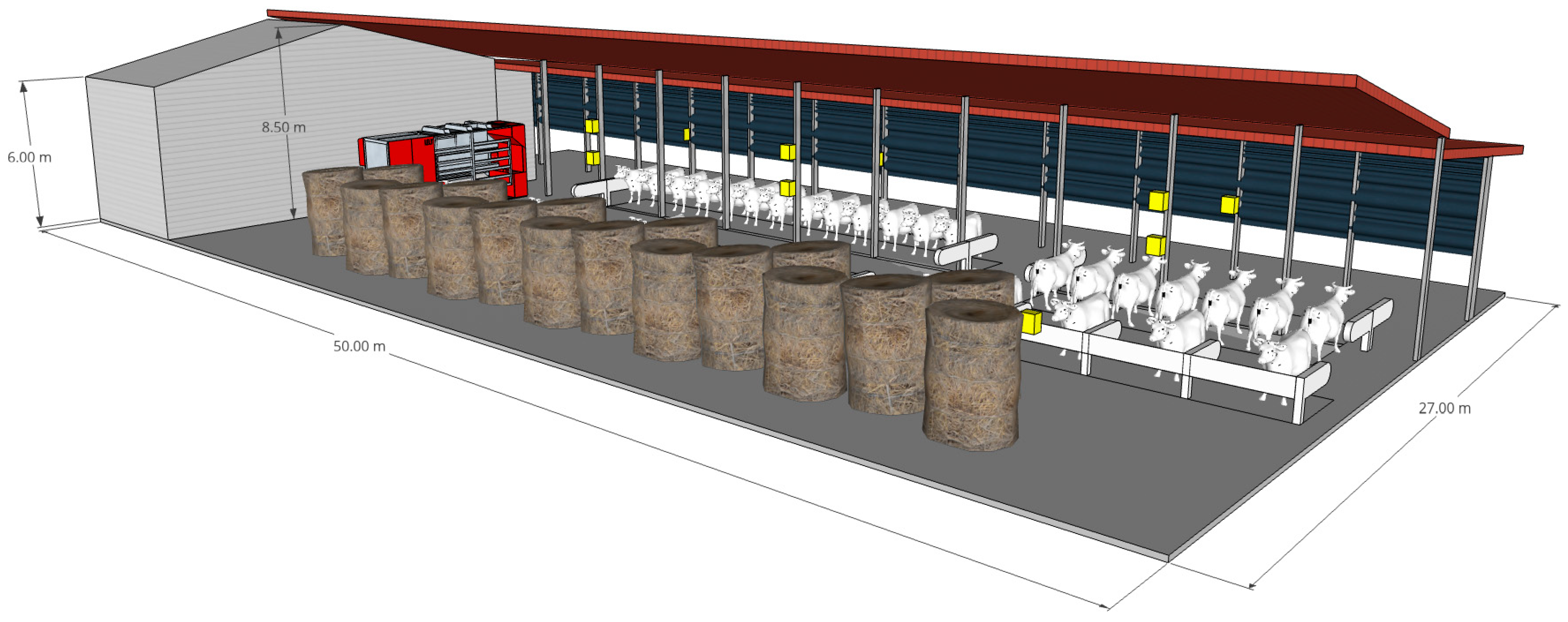
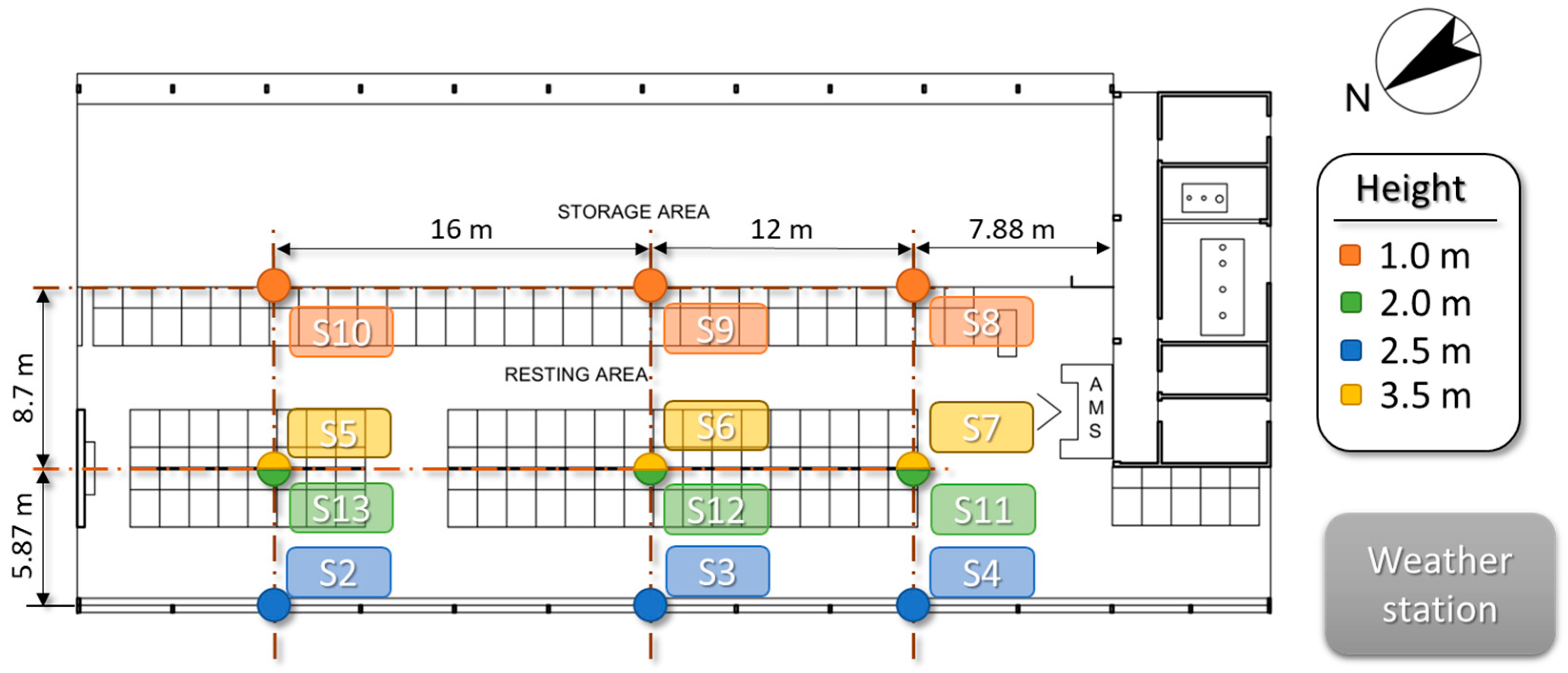
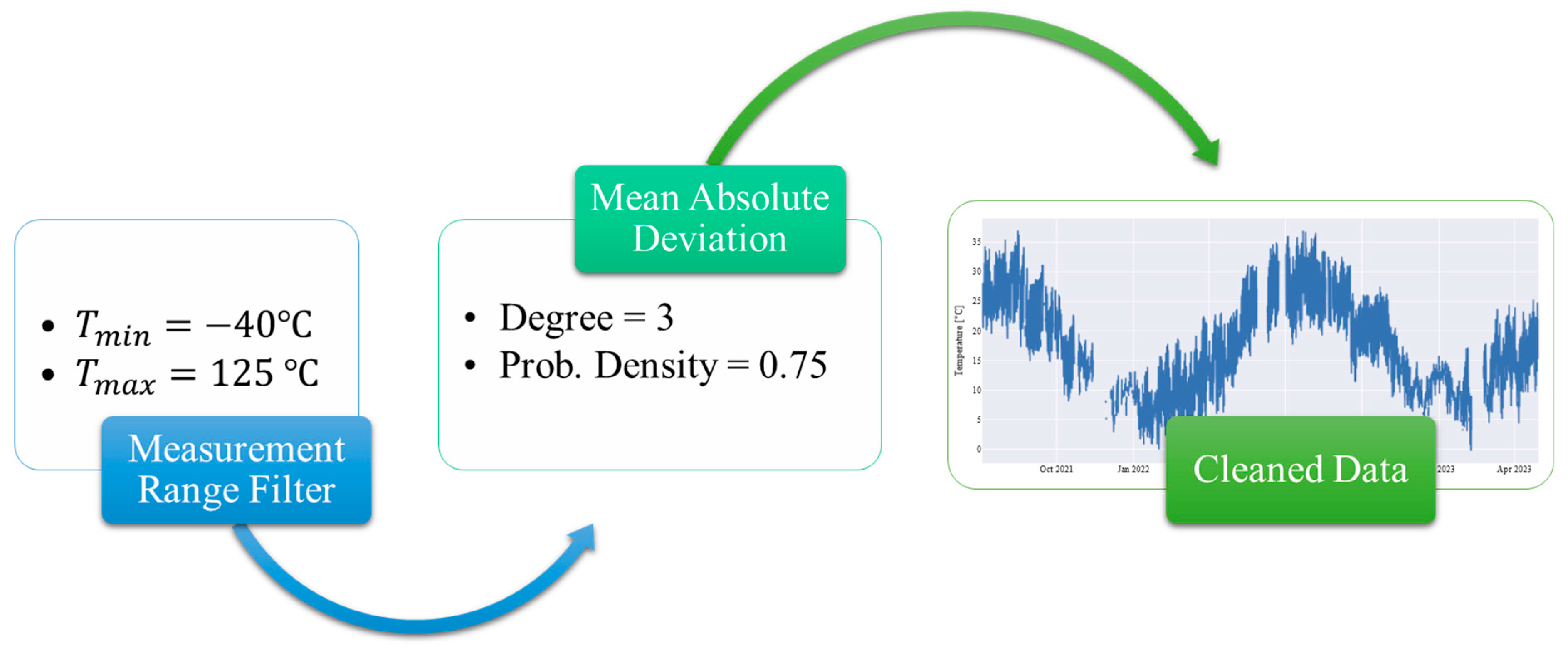


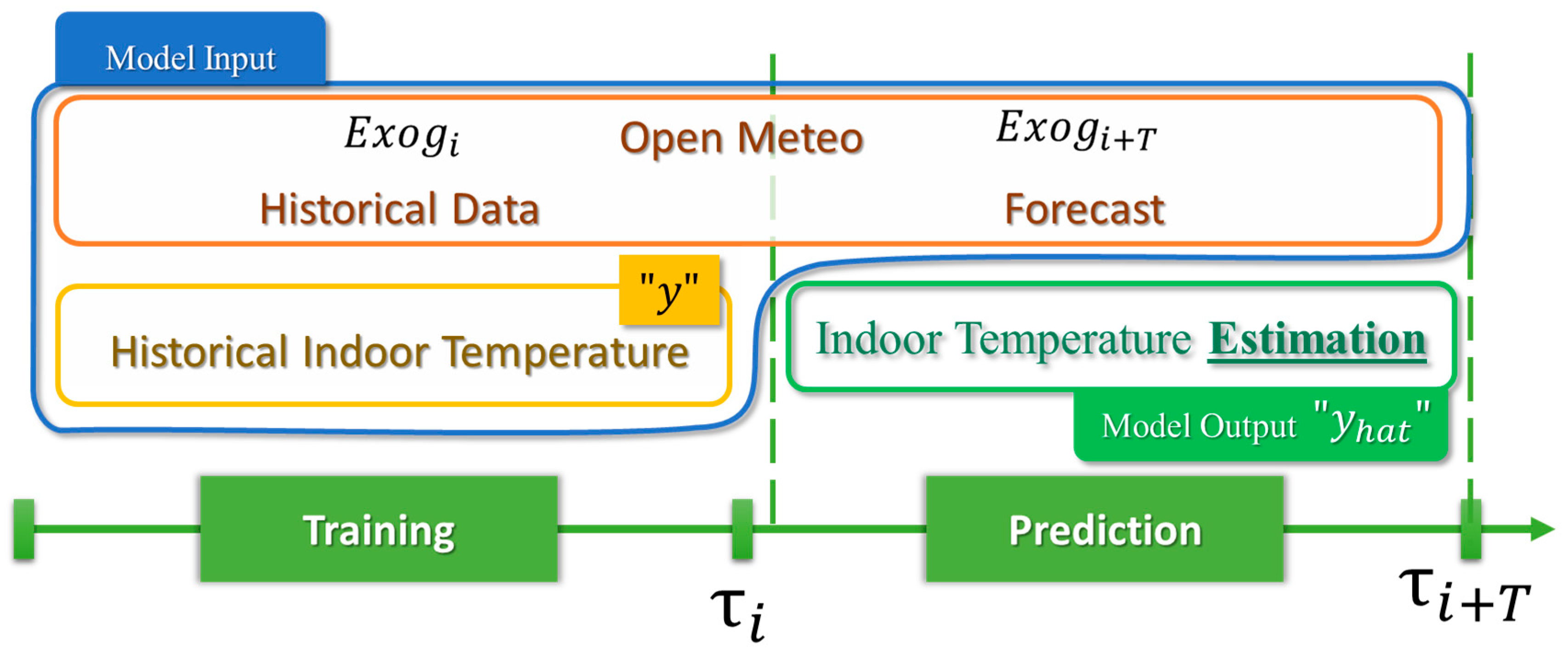

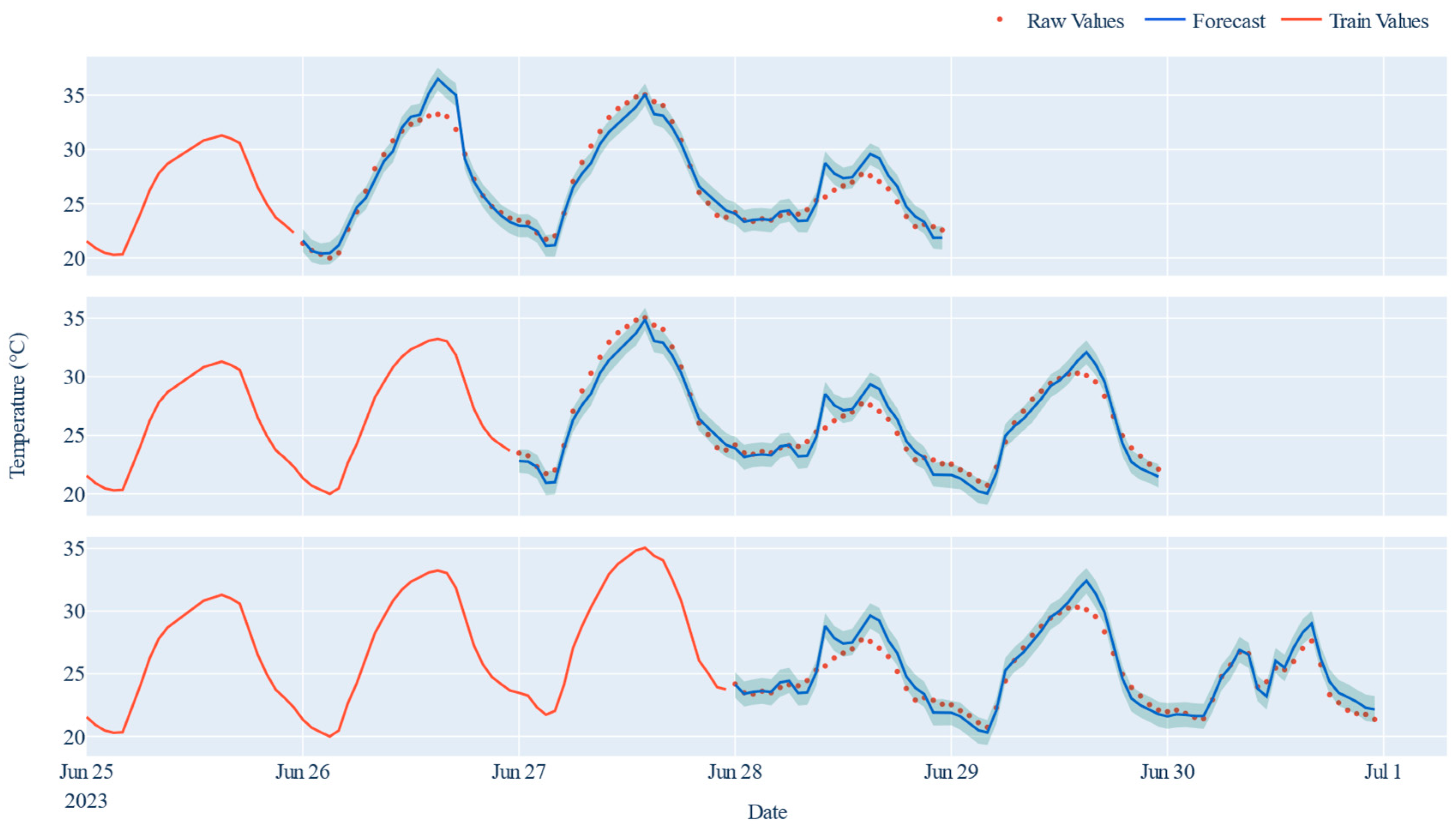
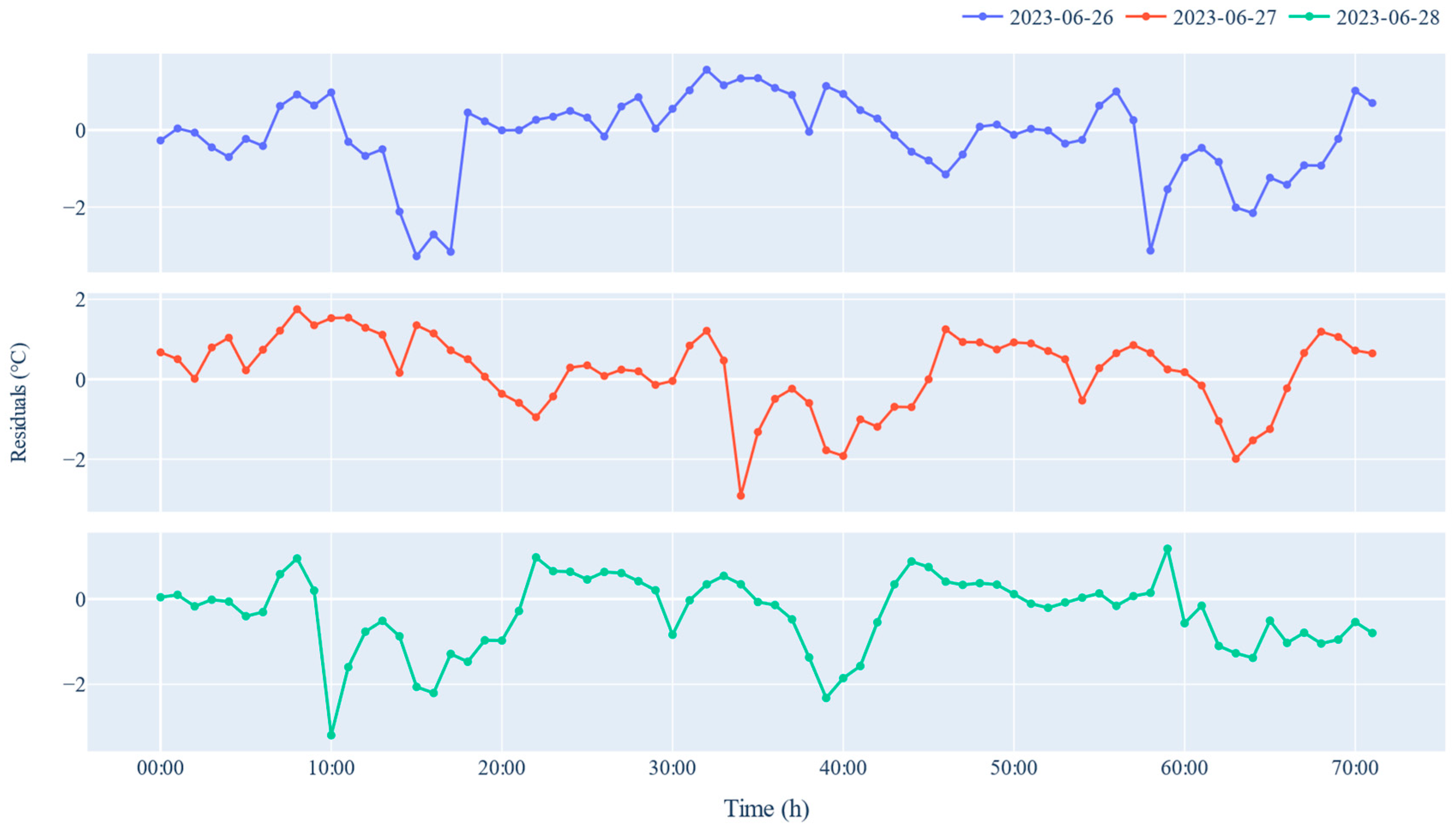
| Sensor Model | Data Output | Resolution | Accuracy | Range | Unit |
|---|---|---|---|---|---|
| HTU21D(F) RH/T | Temperature | 0.04 | ±0.3 | −40~+125 | °C |
| Relative Humidity | 0.04 | ±2 | 0~100 | % | |
| BMP280 | Atmospheric pressure | 0.01 | ±1 | 300~1100 | hPa |
| Variables | Correlation Coefficient | p-Values |
|---|---|---|
| Ambient Temperature | 0.95 | |
| Relative Humidity | 0.88 | |
| Atmospheric Air Pressure | 0.91 |
| Seasons | Start | End |
|---|---|---|
| Spring | 21 March | 20 June |
| Summer | 21 June | 20 September |
| Fall | 21 September | 20 December |
| Winter | 21 December | 20 March |
| Date | MAE (°C) | RMSE (°C) | R-Squared | MAPE |
|---|---|---|---|---|
| 13 June 2023 | 0.684 | 0.857 | 0.959 | 2.62 |
| 16 June 2023 | 0.503 | 0.656 | 0.972 | 1.71 |
| 19 June 2023 | 0.668 | 0.922 | 0.931 | 2.39 |
| 22 June 2023 | 0.730 | 1.085 | 0.943 | 2.55 |
Disclaimer/Publisher’s Note: The statements, opinions and data contained in all publications are solely those of the individual author(s) and contributor(s) and not of MDPI and/or the editor(s). MDPI and/or the editor(s) disclaim responsibility for any injury to people or property resulting from any ideas, methods, instructions or products referred to in the content. |
© 2024 by the authors. Licensee MDPI, Basel, Switzerland. This article is an open access article distributed under the terms and conditions of the Creative Commons Attribution (CC BY) license (https://creativecommons.org/licenses/by/4.0/).
Share and Cite
Perez Garcia, C.A.; Bovo, M.; Torreggiani, D.; Tassinari, P.; Benni, S. Indoor Temperature Forecasting in Livestock Buildings: A Data-Driven Approach. Agriculture 2024, 14, 316. https://doi.org/10.3390/agriculture14020316
Perez Garcia CA, Bovo M, Torreggiani D, Tassinari P, Benni S. Indoor Temperature Forecasting in Livestock Buildings: A Data-Driven Approach. Agriculture. 2024; 14(2):316. https://doi.org/10.3390/agriculture14020316
Chicago/Turabian StylePerez Garcia, Carlos Alejandro, Marco Bovo, Daniele Torreggiani, Patrizia Tassinari, and Stefano Benni. 2024. "Indoor Temperature Forecasting in Livestock Buildings: A Data-Driven Approach" Agriculture 14, no. 2: 316. https://doi.org/10.3390/agriculture14020316
APA StylePerez Garcia, C. A., Bovo, M., Torreggiani, D., Tassinari, P., & Benni, S. (2024). Indoor Temperature Forecasting in Livestock Buildings: A Data-Driven Approach. Agriculture, 14(2), 316. https://doi.org/10.3390/agriculture14020316










